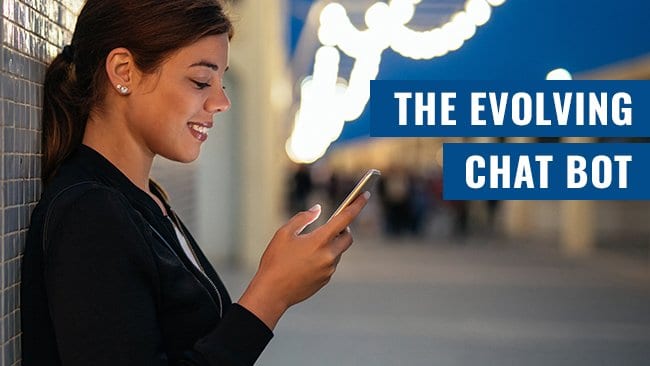
Introduction
Chatbot technology is being driven at a revolutionary pace. Yesterday’s chatbot provider is already obsolete, and today’s chatbot provider faces a juggernaut of competition the likes of which the technology world has never seen. Chatbot platforms are rapidly becoming commoditized as there are so many players with little to no differentiation. The next generation of chatbots will belong to the “Big Six” – Google, Amazon, Facebook, Microsoft, Apple, and IBM.
Top 4 Generations of Chatbots – where is your provider?
The maturity of chatbot providers can be gauged according to the following scale:

- Generation 1 chatbots: are largely glorified faqs. They are able to take rudimentary questions from users and return static data. NLP capabilities are severely limited and in reality, are more of a keyword scan. They have limited effectiveness but have the advantage of being extremely inexpensive to implement.
- Generation 2 chatbots: offered massive improvements over their predecessors. First, we saw the advent of true NLP such that a user’s intent could be better understood. Moreover, these chatbots could do more than just display information – they offered limited transactional capabilities thanks to improved dialog management. Dialog management allowed multiple questions to be tied into a continuous conversation where each subsequent question could be in context to previously answered questions.
- Generation 3 chatbots: was a natural evolution that improved all the core capabilities over generation 2. The AI and NLP technology developed significantly with the ability to understand nuances and semantics. Bots also started supporting multi-media to provide more sophisticated user interaction. Conversations became personalized and companies finally started to realize some promised benefits such as reduced call volume.
- Generation 4 chatbots: is where the world now sits as 2018 nears. The “big 6” combined are investing billions into AI research, which includes improvements to NLP, machine learning, dialog management, and more. These chatbots will also be deployed across all channels and aim to become a ubiquitous part of our lives. The technology advancement in this generation is of such a pace and of such complexity that no other chat provider will be able to compete in this generation. Look for tremendous advancements from these vendors through 2018.
Voice First Browsing
In a piece entitled “Gartner predicts a virtual world of exponential change”, they make the claim that by 2020, 30% of web browsing sessions will be done without a screen. They go on to state that companies like Apple, Google, and Amazon are “turning ‘voice first’ interactions into ubiquitous experiences”.1
This in part is what limits the playing field to the “Generation 4” maturity model above – only those chatbots that are truly multi-channel with the inclusion of voice will be able to reach this classification.
The future Chatbot will be an Ecosystem
The sheer technological advancement coupled with the demanding requirements dictates that the implementation of a fourth-generation chatbot will be an assembly of best-of-breed components. No single vendor will have the capacity or appetite to deliver an end-to-end enterprise-ready chatbot.
The vendors identified as fourth-gen chatbot vendors will be leading the ecosystems. The core chatbot technology will be theirs. However, other vendors will opt-in to the ecosystem and provide significant value-add in being able to deliver an end solution. These ecosystems will be so dominant that even existing 2nd or 3rd generation chatbot providers may end up breaking into their parts to play in the ecosystem in a bid to remain viable.
So what will make up the chatbot ecosystem?
Deploying a fourth-generation chatbot into a complex enterprise is not without its challenges. While the sophisticated AI and NLP are sufficiently “black boxed”, there is still a tremendous amount of work that needs to be done around dialog management and integrating the various assets found in the enterprise.

Figure 2 shows a conceptual abstract chatbot architecture in an enterprise. Integrating all the external systems, customized business logic, heavy services orchestration, and dialog management all add up to a significant code investment.
In fact, none of the Generation 4 chatbot providers currently provide any mechanism to seamlessly integrate these components. The result is extensive coding to combine the elements, which is time-consuming expensive, and difficult to maintain……and relies on an already overburdened IT Services Roadmap.
The primary areas that the ecosystem can provide to aid in the implementation of a fourth-generation chatbot are:
- Orchestration and Business Logic – A customer interaction should be transactional, and these transactions will typically span multiple systems in an enterprise. For example, it may need to pull information from a knowledge base, update a billing system, retrieve previous interaction history from a context store, and more. All of these inner workings need to be orchestrated in a visual, no-coding paradigm to ensure changes can be made quickly, all with a low total cost of ownership.
- Dialog Management – Consumers today expect both “linear and lateral” conversations – Having a framework to aid in managing dialog only improves the capabilities already provided by the fourth generation providers. This allows consumers to have a dialog with the chatbot instead of a series of questions and answers.
- Access to Transactions – Despite the sophistication in the AI layer, even fourth-generation chatbots are only going to be as good as their access to underlying data and transactions. Data for which access is often restricted, and for transactions that often don’t exist. To truly remove the human element and be entirely transactional, it will be necessary to introduce Robotic Process Automation to surface transactions. The coupling of fourth-generation chatbot technology with robotic process automation finally starts to deliver on the promised value of chatbots.
So what’s an organization to do?
Given this strong convergence of technology with a limited number of fourth-generation chatbot vendors, organizations may rightfully be confused as to what implementation strategy they should use. Answering that question in part depends on where you are in your chatbot journey.

“We’ve never implemented a chatbot before but would like to get started”
This may be one of the times you’re being rewarded for not being an early adopter! If you’re now in the consideration phase of chatbot implementation, it is a critical moment to step back and reassess your approach. If your chatbot vendor is not one of the identified fourth-generation chatbot vendors, you may be limiting yourself right out of the gate. You would be strongly encouraged to reassess your bot engagement strategy.
“We’ve implemented a chatbot but we’re not getting the results we had hoped for”
This is a refrain that is, unfortunately, becoming all too familiar. While organizations saw some initially encouraging results, as customer inquiries become more complex, the chatbots became less and less useful. Whether this is due to limitations in the NLP, a lack of machine learning, a lack of dialog management, or the inability to be fully transactional, the limitations of current chatbots are quickly becoming evident. Organizations falling into this category should start planning to move to a fourth-generation chatbot provider in order to future-proof their virtual customer assistant platform.
“We’re already using Google API.AI/Facebook/Amazon but are struggling to bring it all together”.
Congratulations on using a fourth-generation chatbot provider. You’ve made the right decision and you are on a future-proof platform. However, we understand the challenges you face in implementing this in the enterprise and tying together all the various components. At Uniphore, we provide the first graphical drag-and-drop chatbot design environment that brings together the sophistication of the fourth generation AI technology, coupled with dialog management and transactional capabilities – all in a code-free environment. This allows for the rapid assembly of fourth-generation chatbots by selecting the best components in the ecosystem and seamlessly bringing them together.
Conclusion
Fourth-generation chatbots are going to be cross-channel industry-leading AI engines, coupled with an ecosystem of supplemental technologies.
At Uniphore, we help organizations in developing their chatbot roadmap, and we provide a unique “bot framework” to assist in fourth-generation chatbot implementation.
This bot framework includes the ability to create sophisticated dialog management, centralize all the orchestration between the components, and use robotic process automation to surface more transactions and remove the human element. All through a visual code-free environment.
For more information, visit www.uniphore.com
[About the author] As Chief Marketing Officer, Chris’s responsibilities at Uniphore include global Go-To-Market strategy, corporate positioning, and marketing strategy and campaigns. Chris has over 20 years of experience in product management, marketing and software development having held several senior leadership positions. Before joining Uniphore, Chris founded a successful software consulting company providing large-scale software systems to Fortune 500 companies. Outside of work, Chris enjoys app development, automated trading algorithms and provides pro-bono legal services. Chris holds a BS in Computer Science and a JD and is admitted to practice in the State Bar of California
As Chief Marketing Officer, Chris’s responsibilities at Uniphore include global Go-To-Market strategy, corporate positioning, and marketing strategy and campaigns. Chris has over 20 years of experience in product management, marketing and software development having held several senior leadership positions. Before joining Uniphore, Chris founded a successful software consulting company providing large-scale software systems to Fortune 500 companies. Outside of work, Chris enjoys app development, automated trading algorithms and provides pro-bono legal services. Chris holds a BS in Computer Science and a JD and is admitted to practice in the State Bar of California
1 – http://www.gartner.com/smarterwithgartner/gartner-predicts-a-virtual-world-of-exponential-change/
)